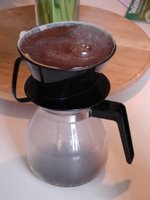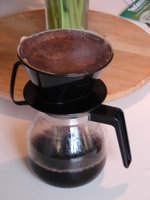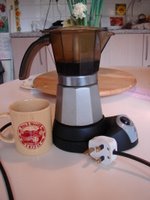Tuesday, April 25, 2006
How to enjoy Hill & Valley Coffee FAQ - Part 1, the basics.
First of all you should know that “coffeespeak” is full of bunkum, over sophistication and subtle commercial positioning. Coffee snobs rarely know what they are talking about and self-styled experts lack humility and the right perspective. Lost in the complexities of the market and it's processes, experts tend to forget that apart from the grower, the drinker is the most important person in the “supply chain”. Those amateurs who claim expert status are often victims of extreme selectivity or worst obsessive tendencies. Most of the commercial interests in the business (in direct proportion to their size and turnover) try to divert you from the obvious to make you choose their brand. The “obvious” is that coffee must be enjoyed freshly roasted, preferably within 2 to 10 days of the roast and ground seconds before brewing. No branded coffee gets close to offering you this proposition and yet only an infinitesimal share of the UK coffee market goes to “obvious” coffee. A remarkable tribute to bunkum! Nowhere in our food industry are smoke and mirrors employed more than in the coffee market. Well, what you can expect when you know who has the “largest share of throat”?
We strongly advise you to heed your own advice above all others and to experiment relentlessly. Find out what works for you, not what others tell you is “best”.
If you want to understand many issues surrounding the complexities of coffee better then an hour or so spent on the excellent Coffee Research Institute website is worth a hundred e-mails to people like me who are trying to sell you stuff. (With a good mug of fresh Hill & Valley Coffee at your side of course!)
Today we'll deal with two of the most basic entry level questions in some length.
How should I drink my coffee?
“Coffee” is drunk black without any additions such as sugar or milk. Any additions bring a whole range of new variables and create a different beverage. If your favourite coffee is cappuccino (a sensational, sensualist idea) then please remember that it is no longer really “coffee”.
So our question can be re-phrased : how do I make my coffee to best enjoy it black?
Our answer is to “keep it simple, stupid!” The two methods we prefer at home are :
Simple drip filter. 
Plastic or ceramic cone over a glass or ceramic pot.
a glass or ceramic pot.
Fresh finely ground beans. Freshly drawn water.
Catch the water just before boiling.
First steep the grounds with a half cup of the water; wait 15 seconds then pour slowly into the grounds until your cone is brim full and you think you'll have enough coffee. If you don't, brew some more – don't refill the cone of already extracted grounds unless you want extra caffeine and bitterness. And next time pour more slowly!
Traditional espresso.
Otherwise known as “moka express, caffeteria, stovetop, stovey etc.” That is one of those Italian, screw-together coffee pots that goes on the stove. Grind as per filter or slightly finer (between caster and icing sugar but still slightly gritty when rubbed between index finger and thumb) Fill the small basket and softly “tamp” the coffee to an even surface. Fill the bottom part with water to just below the valve; drop the coffee funnel on top and screw the top on tightly. Place on the stove at full heat, turning the heat down when the water starts to percolate. Remove immediately when extraction has finished and pour. I recently bought an electric version of this in Spain for around 60 euros (a Delonghi Alicia) and it has improved the experience mainly due to its “walkawayability”. I think they are now available online in the UK for about £50.

We don't like cafetieres (french presses) and are amazed at people's mock francophile love of them as the french never use them! In most people's hands they tend to over-extract the coffee and produce bitter mud out of a bright vibrant beverage. It is one area where the Coffee research people and I differ and where I think they have forgotten that coffee is made by ordinary people! Make up your own mind.
You can make good tea in them though, so don't throw them away immediately.
If you want to invest in some more sophisticated coffee equipment at home, first go for a burr grinder. Generally speaking if you spend £50 -£60 or so on an entry level Gaggia ( I use an MM), it will improve all your coffee immeasurably. Uniform particle size in the grind is an essential element in an even brewing extraction.
If you truly feel you must imitate the espresso / cappuccino / caffe latte experience each time you have coffee at home, then there are several high end home espresso machines on the market these days. We particularly like the Rancilio Silvia, but with the need for an equivalent quality grinder, you will be investing more than £500 in your daily cup of coffee. At Ryanair prices that would give you 10 daytrips to somewhere like Treviso in north west Italy where you could gorge yourself on great coffee all day and soak up the atmosphere as well. You might even get some Serie A football or top grade Rugby into the bargain if you time it right. If you already have a set-up like this then a question in the next part of this FAQ may help you with some of your frustrations.
You have many coffees on offer, which should I choose?
If you are new to buying fresh high quality coffee, then the journey will be long and immensely rewarding for you. You can literally start anywhere in our range, but if you do take the random walk approach, you should remember where you came in! We can give you a few clues, but a lot of this is down to you – there is no prescriptive approach.
First piece of advice – you are unlikely to immediately enjoy what I call “big acid coffees”. In our range, most of the coffees from Kenya and Central America will fit into this category. Our Kenya AA in particular is an acquired taste, but once you get there, you will probably want to stay. In general the preponderence of soluble coffee and blandness in roast and ground coffee in the UK has left people unprepared for the complexity of these high grown coffees (in much the same way we go for fruity new world wines in preference to high tannin Bordeaux and Burgundy these days).
Second piece of advice – if you drink your coffee with milk (stop that, will you?) you should choose a coffee that we have roasted to accentuate body and “guts”, ie. slightly mork dark. Just a quick aside here, we don't roast dark to hide defects in cheaper coffee as many do, we roast dark to diminish acidity and bring out other flavours in our coffee. All our Indonesian arabicas are good starters in this respect.
Third piece of advice – why not start with a coffee from an area that you know something about? If you have any form of attachment to a country or its people, why not try the coffee and try to imagine the lives of those that produce it while you are drinking it? I have no doubt that the prices some people are willing to pay for coffees from Australia, Jamaica and Hawaii are due in large part to post tourism purchases and the nostalgia attached to that first experience of drinking coffee grown “just over there”. Not many people have done a trip to the southern highlands of Ethiopia – but I'd drink a cup of Yirgacheffe at £3 a bag every time in preference to a cup of Australian Mountain Top at £10 a bag! Ethiopia is as good a place to start for several reasons. Most of us can remember Live Aid (or even Live 8) and Ethiopia is the “origin of origins”.
Fourth piece of advice – and this follows from my remarks on prices above. Never be fooled into thinking that you more you spend, the “better” the coffee will be. The “designer luggage” approach to coffee is good (the more flashy the label, the less it may be usable). The unique micro producer coffees can be very rare (St. Helena, Jamaica, Puerto Rico, Hawaii) and their very rareness attracts a certain type of buyer who may or may not have a clue about comparative tasting. But in that buyer will never have value for money as their main concern. There is no miracle ingredient that makes Jamaica Blue Mountain ten times the price of top Kenya AA, but there is a solid annual demand from habitual users (Japan) and an extremely finite supply. The prices of Colombian versus Galapagos coffees demonstrates the idiocy of how markets work where supply is extremely limited. When you buy a really top Colombian such as our relationship coffees the price is reasonable, and you are getting some of the best from a rigorously competitive local market out of a crop of more than 11 million bags. The whole of Galapagos produces less than the co-ops we have bought from in the past three years under the relationship coffee programme. So if you start with that you are getting a good impression of what you can get for £3 a bag.
Last piece of advice – and it may seem obvious. If you are buying coffee to use in an espresso machine, then buy an espresso blend. We road test all our espresso blends, not in a lab, not between tasters nodding and shaking heads, but face to face with thousands of coffee drinkers. The bloke who sources the green also blends and roasts it. But this is where we are truly unique in the field of espresso in the UK – that same bloke also pulls most of the espresso shots on our travelling coffee bars. March and April, the first two months of our season, are periods of intense experimentation and fine tuning, usually at just the time new crop coffees are starting to arrive. All four of our current espressos have their unique characteristics and we would hope you would try all of them in your home environment before turning to your own blends. However we would never discourage this experimentation at home and are happy to share blend percentages with regular customers to guide their own progress. (We won't publish these percentages online as we have been plagiarised by competitors who should know better for the past 4 years!) If I had to choose a starting point among these blends it would be e.caffe. The reasons will be apparent if you tried them all!
I enjoy reading your blog and it's great to see this FAQ started. What I would like to see included at some point are roasting tips for your "green" single origins and blends. I understand that it would be impossible to duplicate roasting profiles and results at home, but a few tips would help us home roasters fine-tune the roasting process rather than starting from scratch. So, some general directions for each coffee would be great, such as get to first crack asap or slowly, prolong time between first and second crack, drop the heat and coast through second crack for a minute, etc. As the home roasting "movement" grows and new equipment or modifications are introduced, a lot of home roasters are now able to go beyond just pressing a button and looking at the colour of the beans and can do some elementary "profiling" even with modest equipment. A bit of help from pros like you would therefore go a long way.
Cheers
George
If you pay for the coffee, drink it how you like - don't listen to any pompous "you should drink it this way" twaddle.
How about if you drink your water with coffee (stop that, will you?) Ban the latte!, Outlaw the cappucino! - its just snobbery and that tastes worse than Nescafe.
Returning to the issue, I think that you simply cannot advance your knowledge of coffee characteristics past the general without drinking it black. That's the point I was trying to make, probably clumsily, but this is a blog, not an edited publication, so excuse the language.
As for outlawing the cappuccino and the latte, I hope it doesn't happen as I make my living from those two drinks! Some of them could be made better, though, don't you think......
I'm the lowest of the low because I like Tico Suave filter brewed with Tesco whitener in it - Tesco's own is better than Coffeemate ;-) and a bit of brown sugar as well - sorry, I just can't help it. I do have it black sometimes and its great and I have cappucinos and they're great too.
I think this is why coffee will never be held in the same regard as wine. There to many variables in a cup of coffee, and too many ways to mess it up (like I do most of the time). 9/10 people can open a bottle of wine, 9/10 don't have the skill or the time to brew a decent coffee.
Hill and Valley coffee is top notch even if do you unspeakable things to it, so thanks Charles.
I live in a hard water area and I've found it can spoil the flavour of my coffee quiet a bit. I use Brita filter which helps but is there a better way of getting decent water?
thanks.
If you live in the Thames Water area, not even a Brita Filter will do it, and often these remove all trace elements, some of whom actually improve the coffee.
I could go on for days about how important water is, and don't even mention it to any roaster in Italy unless you are completely prepared!
Over there blends are "regionalised" to match water and each city thinks their water is "the best" for coffee especially in the south. I have sat and listened to a diatribe on how Naples has the best city water for coffee at the same time as being advised not to drink it due to pollution!
The general rule is "not too soft, but definitely not too hard". Studies by the SCAA (Speciality Coffee Association of America) suggested less than 100 ppm (mg/litre) of Calcium was critical and that chlorination also guaranteed a harsh taint to any fine coffee. That's not so bad in dark roasts and even some espressos, but can potentially ruin a coffee like Ethiopian Sidamo or a fine Costa Rica.
I have personally found considerable success with "softish" table waters from certain parts of Wales and Scotland - granite, not limestone aquifers of course. Next time you are in your local supermarket check out some of the 5 litre bottles. They should all carry mineral and other impurities contents on the side. A bit of trial and error might be needed, but most of these waters are mercifully very cheap.
The mantra of : good water - fresh ground freshly roasted beans - correct brewing temperature, should be considered with pretty much equal weight to the 3 elements.
www.big-rick.com/coffee/waterfaq.html
I'll try some bottled Highland water this weekend and let you know how I get on.
One more question...
Whats the best way to store your coffee beans once they've been delivered. I put the opened and unopened packs it a poyethene bag, then put it in the freezer. I grind the beans 'frozen' too. Probably a big no-no.
thanks
Nathan
<< Home


